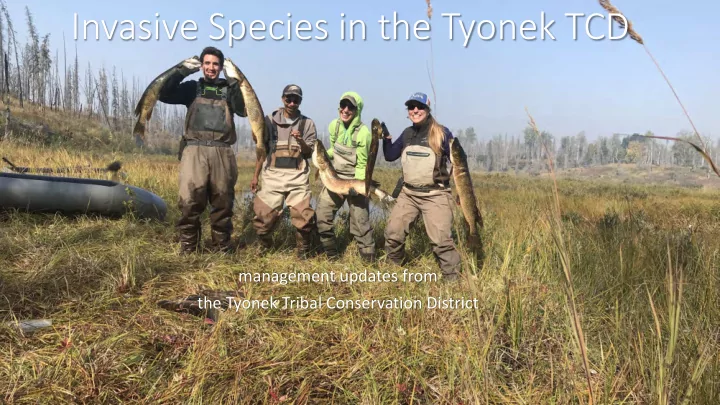

Invasive Species in the Tyonek TCD management updates from the Tyonek Tribal Conservation District
Tyonek Tribal Conservation District • 6 million acres, 4 communities • Split between Mat Su and Kenai Boroughs • Mission: To conserve, enhance, and encourage the wise use of natural resources. • Core Values : • Meet needs of stakeholders • Foster cooperative relationships • Community driven conservation • All projects start as a community idea or concern • Board consists of tribal council, Tyonek Native corporation board, and at large board members • TTCD provides facilitation and technical assistance
TTCD’s Programs • Tyonek Grown • Increase food security and food sovereignty in Tyonek • Train youth and interested community members how to sustainably grow food • Tyonek Youth Conservation Science • Teach science education in Tebughna school • Technical Assistance • Provide technical assistance for conservation projects • Habitat Monitoring and Restoration • Works to conserve essential food and cultural resource: Salmon • Replace culverts that block salmon from breeding grounds • Monitor and control invasive species
Invasive Plants in the TTCD • Began monitoring for terrestrial invasive species in 2014 • Surveyed 100 miles of road • Surveyed 60 miles of streams and rivers • Surveyed 1,100 lake acres for elodea • Found and prioritized infestations and looked for partners to take action • Treating terrestrial invasives in Beluga since 2015 • Orange hawkweed approximately 90% reduced • White sweet clover infestation- immediately shut down section of gravel pit • Continued oxeye daisy management 2017- current
Mat Su Waterways • 35 miles of Alexander Creek infested with RCG • RCG in Skwentna in Bottle Creek, unknown extent • Alexander and Sucker Lakes Complex now considered full lake infestations of elodea • TTCD is now coordinating elodea task force to combine partner resources to tackle this pressing, complex, and expensive issue
Elodea: Alexander and Sucker Lakes Task Force • Established in November 2018 with goal to collaboratively support DNR’s efforts to eradicate elodea • Approximately 32 members representing state, federal, private, corporate, and nonprofit stakeholders. • Accomplishments: • Sport fish closure for Alexander and Sucker Lakes • Funding assistance through in-kind donation, grant writing, and donation solicitation • Elodea survey organization, protocol standardization, and fundraising • Assisted in permitting processes • Numerous outreach opportunities • Civil Air Patrol Facebook, KTVA, Alaska Native News, ADN, Alaska Journal of Commerce, Alaska Airmen Transponder • Elodea present signs posted for float plane pilots Sucker Lakes Landowner Walt Nesbett poses with newly installed “Elodea Present” sign
Elodea: Where we are and next steps • Continue fundraising for 3 years of treatment • Focus on containment while we wait for funding: • Continue outreach initiatives reaching pilots, landowners, and other recreational user groups • Continue elodea survey protocol standardization and implementation • Consider diquat and other containment measures Landowner Bob Pence’s photo of elodea turning brown one day after diquat treatment.
Northern Pike: • TTCD priority issue • Build partners while defining the issue • Collaborations continued with ADFG biologists, NVT, and CIAA • Partners were able to cover staff time and expertise • Grants covered travel, room and board, and supplies • ADFG developed mark- recapture studies • 2018 Threemile Lakes • 2019 Chuitbuna
Threemile 2018 Female Male Average 382 363 Threemile Results Median 363 353 Min 210 205 Max 935 985 • 2018 Threemile 3 lake complex • Removed 1,300 pike • Approximately 50% reduction in population estimate (>300mm) in the first year • 1,246 stomach contents analyzed Threemile 2019 • 2019 Female Male Average 336 322 Median 320 310 • Removed 1,316 pike Min 125 121 Max 658 679 • 1076 stomach contents analyzed
2018 Stomach Content Composition, Threemile Sticklebacks, 6% Salmon, 8% Leeches, 11% Dragonflyies, 52% 2018 Total Salmon 327 Stickleback 102 Scuds, 40% Pike 44 Unidentified Fish 44 Total Invert 4889 2019 Stomach content composition, Threemile 2019 Total Salmon 646 Unidentifiable Stickleback 14 Water boatmen, Fish, 3.4% Pike 28 4.5% Salmon , 11.8% Unidentified Fish 40 Leeches, 6.4% Total Invert 6184 Scuds, 39.6% Dragonflies, This work matters. 57.1%
Chuitbuna 2018-19 • 2018 • Identified as next priority population • 13 huge pike full of salmon in 2 hours • 2019 • ADFG developed mark recapture study • Mark: June 1 st - 4 th , 64 tags • Recap: June 16 th – 19 th , 53 recaps • Removed 190 pike, (121 pike >310mm) • Preliminary pop estimate around 150 for pike longer than 300mm • Removed approximately 80% of population over 300mm in length! • Salmon in 30% of stomachs, fewer salmon total
Chuitbuna Creek: Rollercoaster Lake • Surveyed for Pike in June, one observed • NVT and TTCD suppression effort in August • Significant capacity building achieved with ADFG support • Removed 28 pike in 48 hours of netting Salmon 0 • Large, isolated, hungry pike Stickleback 66 UI Fish 13 • 1/3 stomachs empty Dragonflies 13 Leeches 2 • Ave fork length: 513mm Mammals 2 • Max: 1020mm Min: 220mm • Stickleback and LNS cohabitating, Coho in productive creek • We’ve now removed over 3,101 pike! Will continue all suppression in Threemile, Chuitbuna, and Rollercoaster Lake in 2020
Tyonek Tribal Conservation District Program Contact: Nicole Swenson- Conservation Director / nswenson@tyonek.com Christy Cincotta- Executive Director / ccincotta@tyonek.com TTCD on the Web Jillian Jablonski- Conservation Technician / jjablonski@tyonek.com www.ttcd.org and Facebook @TyonekTCD Tonya Kaloa- Program Assistant / tkaloa@tyonek.com Thanks to our supporters / collaborators: Cook Inlet Region Inc., Tyonek Native Cooperation, Native Village of Tyonek, US Fish and Wildlife Service, Natural Resource Conservation Service, Alaska Department of Fish and Game, US Geological Survey, University of Alaska- Fairbanks, Cook Inlet Aquaculture Association, Copper Rive Watershed Project, Cook Inletkeeper, Spernak Airways, Hillcorp Inc., Chugach Electric, Threemile Creek Services, Alien Species Control, Alaska Department of Natural Resources, The Great Land Trust, and our numerous individual supporters across Alaska.
Recommend
More recommend